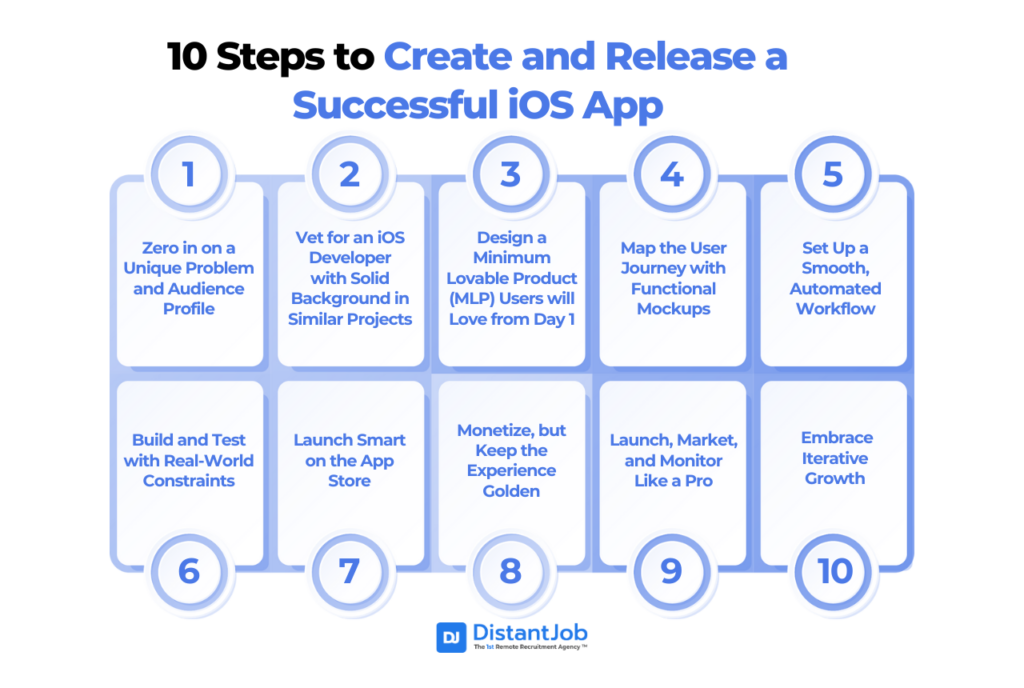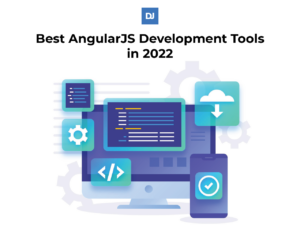To create a great iOS app for your business, you need a good plan and the right tools. Outlining key features and picking a capable development team are just two of many steps that help turn your app idea into reality. But how do you get started if you’re new to making apps or don’t know much about tech?
The iOS app market worldwide hit $240 billion last year, and experts predict mobile apps will bring in over $935 billion by the end of 2024. This means a lot is on the line. A well-developed app can connect you straight to customers, make your brand more visible, and create new ways to make money. But every little thing matters—from making the app to putting it out there can affect how well it does overall.
You already know that building an iOS app can change your business for the better, but how can you begin if you’re not a technical expert? This guide shows 10 practical steps made for busy business owners. We’ll help you find a reliable developer, focus on features that add value, and prepare your app for the App Store—while steering clear of common (and expensive) mistakes. Let DistantJob’s industry know-how lead you from concept to release.
10 Steps to Create and Release a Successful iOS App

Creating an outstanding iOS app begins with a clear goal and a solid strategy. From getting to know your users to improving your app’s features, each phase prepares you for an easier launch and a better connection with your audience.
These 10 steps will guide you from idea to App Store success:
Step 1. Zero in on a Unique Problem and Audience Profile
A winning app starts by tackling a real everyday problem your target users face—one that current apps haven’t fixed. Rather than making “just another app,” try to offer something that meets a clear unfilled need.
What’s more, zeroing in on a unique underserved problem goes beyond just creating an app—it has a significant impact on maximizing your return on investment. When your app meets a specific need, you’re likely to draw a committed user base quicker resulting in higher customer retention and faster time-to-value. By targeting users who truly need and want your app, you steer clear of wasted resources and boost profitability from the get-go.
DistantJob’s Insider Approach to Finding the Right Problem and Audience:
- Dig Deep into Niche Communities and Reviews: Don’t just stick to app store reviews. Check out specialized forums, Reddit threads, or industry Slack channels where your potential users talk about their problems. Try to spot recurring issues and feature requests that show where your app could step in. Let’s say users often bring up a scheduling app’s poor integration with other tools – that might be your chance to shine.
- Create a Detailed Pain Point Map: Don’t stop at general user personas. Build a “pain point map” for your ideal customer. This map should spell out the exact daily challenges they face that relate to your app’s purpose. Find the specific moments or situations where your app would fix an immediate problem. Let’s say your app idea is for logistics tracking. In that case, map out the exact instances where delays or poor communication mess up the workflow.
- Validate Through Lean Testing: Rather than putting money into complete prototypes, go for clickable wireframes or quick 5-minute surveys to get fast input from actual users. DistantJob often tells its clients to try this step as a “low-cost test” to make sure the idea matches what users want. This helps you check if the app concept works on using just a little bit of resources to see if it fits the market.
Pro Tip from DistantJob: Team up with an iOS developer who knows your field from day one. A developer with similar project experience can give you a heads-up on possible tech hurdles (like battery issues in GPS-heavy apps) and come up with clever, growth-ready answers that fit your app’s goals.
At DistantJob, we’ve seen up close how a developer who gets your industry can spot ways to boost app features and user experience early on making each phase more productive and budget-friendly.
Step 2. Vet for an iOS Developer with Solid Background in Similar Projects
Finding the best iOS developer goes beyond just looking for someone with coding skills. You need a partner who gets the unique challenges of your project. A developer with real-world experience in your field or with similar apps will bring more to the table than just code. They’ll spot potential issues, make features work better, and come up with useful ideas to improve your app.
DistantJob’s Insider Approach to Selecting the Right Developer:
- Seek Developers with Scenario-Specific Experience: When your app needs complicated features, like syncing data in real-time using location services, or working offline, look for developers who’ve tackled these issues before. For instance, a developer who’s worked on apps that use a lot of battery power (think fitness trackers or GPS apps) will know how to balance performance and energy use. This is key if you want to avoid users complaining about their battery draining too fast.
- Conduct Scenario-Based Interviews: Regular questions don’t show how well a candidate can deal with real-world problems. At DistantJob, we suggest using scenario-based questions to uncover problem-solving skills that relate to your app’s specific needs. For example, ask, “What would you do if a surge in user activity caused slow load times in a live streaming feature?” These practical questions give you a glimpse into the developer’s ability to adapt and their hands-on experience.
- Check Their GitHub or Portfolio for Evidence of Scalable Coding: Look beyond just their showcase projects. Search for code that’s broken down into parts well-explained, and shows they care about keeping things easy to update and grow—these are signs of a coder who thinks ahead and isn’t just trying to finish quickly. Developers who write clean organized code make it much easier to make changes and fix problems later, which you’ll need as your app gets bigger.
- Ask for Specific Examples of Past Solutions: Rather than general achievements, ask about specific challenges they’ve solved that match your app’s needs. For example, if your app deals with sensitive information, a developer who can talk about how they handled secure data storage or encryption in previous projects will bring useful security practices to your project.
Pro Tip from DistantJob: Working with a seasoned agency like DistantJob gives you a chance to tap into a pool of pre-vetted candidates with proven industry know-how. Our team searches for both technical abilities and experience in specific scenarios. This means candidates can dive into your project with a shorter learning curve focusing on making strategic high-impact contributions right off the bat.
Step 3. Design a Minimum Lovable Product (MLP) Users will Love from Day 1
When you’re rolling out a new app, it’s not enough to shoot for a “minimum viable product” (MVP) that just does the job. A Minimum Lovable Product (MLP) takes it up a notch—it’s all about giving users a sleek polished experience they enjoy from day one. Putting your energy into an MLP means you’re zeroing in on features that don’t just tick boxes but create a positive unforgettable experience. This way of thinking builds user loyalty on and lays a rock-solid groundwork for future tweaks and updates.
Also, for small businesses with tight budgets, focusing on an MLP is a wise money move. Focusing on key features cuts initial costs and delivers a refined experience that inspires early positive feedback and organic recommendations. This smart approach to getting and keeping customers paves a clearer path to ROI, while pleasing users on creates the loyalty needed for sustainable growth.
Insider Tips for Building a Compelling MLP:
- Pick 3-5 Core Features That Stand Out: Figure out the main tasks your app needs to perform well and work on making these great instead of trying to do too much. Let’s say you’re making an app to help people accomplish their goals effectively. You might want to focus on optimizing task management and making sure it works with calendars. When you zero in like this, you end up with top-notch features that keep people coming back to use your app.
- Get Input Using Detailed Wireframes: Instead of basic wireframes, use detailed mockups that show your app’s look and how it works. These help you test how your app “feels” and get user feedback on ease of use and design before you start building. This step can uncover surprising user likes and usability problems that might not come up later.
- Make Every Interaction Enjoyable: Keep things simple and easy to use so that even your main features feel natural and fun. Little touches—like smooth movements easy-to-use menus, and quick touch responses—make the user experience much better. These design choices aren’t just about looks; they create lasting impressions that build user loyalty and keep people coming back from the start.
- Build Your Prototype with Real-World Use in Mind: As you develop your MLP, consider how people will use it in everyday situations. Run tests where actual users complete common tasks, like scheduling an appointment or adding items to a wishlist. Watching how people interact with the app in practical scenarios can reveal any problems or confusing steps letting you make improvements before the full release.
Pro Insight: When you build an MLP that makes users happy, you create loyal customers from the start. If you make a polished MLP with key top-notch features, you give value and get useful feedback for future updates. This sets your app apart from rivals who just offer basic MVPs.
Step 4. Map the User Journey with Functional Mockups
To make an app easy to use, you need to design a path that feels natural from the first click. If you build functional mockups that copy real user actions, you can find any navigation problems before you start full development. For each screen, think about what makes the path easy to follow and cut out any extra complexity.
Insider Tips to Build Functional Mockups Like a Pro:
- Build Interactive Prototypes with Specific User Flows: Skip static wireframes. Create clickable mockups with real-world flows. Let’s say your app has multi-step processes like sign-ups or purchases. Set up your prototype to walk through each step in order. This shows how people will use your app helping you spot and fix potential issues early on.
- Target Pain Points with Scenario-Based Testing: Find testers who match your main app users, and put them in real-life situations. For example, “Picture yourself as a restaurant owner tweaking your menu while out and about.” Keep an eye out for moments where they pause or look confused. These highlight specific trouble spots linked to what your users need in their day-to-day lives.
- Streamline Screens to a Single Objective: Each screen should point users to one main action. Take adding items to a list as an example. In this case, show controls that matter, like “Add” and “Remove”. Clean screens become crucial in busy settings where people might do multiple things at once.
- Test on Real Devices in Real Conditions: Desktop testing isn’t enough. Try out mockups on mobile devices in different situations—dim lighting, shaky hands, spotty Wi-Fi. This brings to light ease-of-use problems that often slip by in perfect test setups making sure the app works well after its release.
Pro Insight: Don’t test with your in-house team. Use “cold” testers who know nothing about the app. Give them minimal instructions to see how first-time users experience it. This uncovers small usability issues you might miss otherwise. Testing this way cuts down on fixes after launch and makes users happier from the get-go.
Step 5. Set Up a Smooth, Automated Workflow
A well-oiled automated workflow keeps your iOS development nimble and able to grow. When you automate routine tasks and build a solid framework, you keep quality high and catch problems before they slow you down. This works great for small teams looking to get the most out of what they have.
And, in fact, automation isn’t just about efficiency; it impacts scalability and cost-effectiveness too. An automated workflow cuts down on mistakes and speeds up the development process, which leads to reduced ongoing expenses. For smaller companies, this means they can do more with fewer people letting the business grow without having to spend as much on overhead costs.
Insider Tips to Boost your Automated Workflow:
- Build a Custom CI/CD Pipeline for Continuous Testing and Deployment: Put together a pipeline that tests code and gets it ready for deployment whenever you update. Set up different branches for stages like staging (for in-house testing) and production (for live deployment). This makes updates smoother and cuts out the need to test by hand at each step.
- Automate Routine Tasks Like App Store Prep and Metadata Updates: You can set tasks to run by themselves such as making app screenshots refreshing info, or handling app releases. This saves time and helps avoid mistakes. For apps in many languages, use updates that change on their own. This keeps each version the same across all languages without doing it by hand over and over.
- Use Real-Time Monitoring to Spot Bugs and Performance Issues: Set up instant notifications for app crashes, bugs, and slow performance. Break down data by device type, OS version, or specific user paths. This lets you tackle the most important issues first, boosting user happiness on the spot.
- Set Up Code Quality Standards to Keep Teams on the Same Page: Run automatic checks to stick to consistent coding rules and catch problems early. Build a shared library of coding standards and write down common methods. This helps new developers get up to speed faster and pushes for top-notch code as your app gets bigger.
Pro Insight: A good automated workflow doesn’t just save time; it makes your team stronger letting them focus on creating new features instead of always dealing with fixes. Smart developers understand that putting effort into a solid workflow setup pays off over time making growth easier and updates smoother.
Step 6. Build and Test with Real-World Constraints
Creating an app that works well in everyday situations requires more than just ideal-condition testing. Many apps run in simulations but struggle with common user issues like slow internet, older phones, or low battery. Testing for these limits helps make a tough app that meets user needs no matter where they use it.
In the end, testing in real-world conditions makes sure your app works well in different user settings, which matters a lot for keeping customers. Users are more likely to stick around if the app works without problems in their daily life cutting down on people leaving and boosting how much each user is worth over time—key numbers for getting the most out of your investment.
Insider Tips for Testing Under Real-World Conditions:
- Run Tests on a Variety of Device Types: Check your app on many different devices, including older ones with less power. Try it with slow internet to see how it handles delays, and test it on different OS versions to make sure it works well. Testing on many different setups helps you avoid common speed bumps as early as possible.
- Validate Performance on Real Devices for Real Conditions: Simulators can do so much, so test the app on actual devices to get a true feel for how users will experience it. Set up a lab with real devices or use outside services that copy different real-life situations, like weak Wi-Fi, changes in light, and how well it responds on mobile.
- Keep and Eye on Battery and Data Efficiency: Apps that drain batteries or eat up data often get deleted so watch these numbers from the start. Work on ways to make your app less demanding on users’ devices making sure it runs in different situations without using too much power or data.
Pro Insight: Tests under real-world constraints don’t just prevent performance problems. They also reveal where tweaks can give your app an edge over competitors. A developer who knows how to test for toughness can make sure your app keeps working well under everyday pressures. This builds trust and makes users happier.
Step 7. Launch Smart on the App Store
Getting your app on the App Store is just the start. To stand out in a crowded field, you need a good plan for your launch. Everything matters – from how you submit to how you show off the app. These things affect who sees your app and how many people use it. A clever launch can boost early downloads and lay the groundwork for long-term success.
Insider Tips for a Smooth and Effective Launch:
- Check Submission Requirements Beforehand to Skip Holdups: Before you submit, use the “Prepare for Submission” tool in App Store Connect to spot and fix any issues it flags. Pay special attention to Apple’s rules on how your app works and how it handles user privacy, as these are the main reasons apps get turned down. Making sure you follow the rules from the start cuts down on the chance of your launch getting held up and helps the review go more smoothly.
- Use ASO (App Store Optimization) to Boost Discovery: Research keywords that match what your ideal users search for. Create a title that showcases benefits and a subtitle rich in keywords to highlight what makes your app special. In your descriptions, be clear about how your app fixes a problem or enhances people’s lives. This approach appeals to both the App Store’s search system and potential users.
- A/B Test Visuals to Increase Download Rates: Test various screenshots, icons, and preview videos to see which ones click with potential users. Try options that show off main features or user perks right away. Use Apple Search Ads to run tests and find out which visuals grab the most attention. Then, tweak your listing based on real performance data to make it as appealing as possible.
Pro Insight: Begin your ASO and A/B testing well ahead of your launch to make sure your listing is in top shape when you go live. Take care of compliance issues and improve every part of your listing, as the App Store has tough review standards. This prep work not only helps people find your app more but also gets your downloads off to a strong start.
Step 8. Monetize, but Keep the Experience Golden
Making money from your app matters, but you need to do it in a way that feels right and gives value to users. A successful monetization plan integrates revenue options without compromising the app’s usability or user satisfaction. When you add ways to make money, you make the app better for users and keep them coming back while getting the most cash from your app.
Thoughtful monetization matches what you want with what users like creating a mix that helps you make money for a long time. By trying out and fixing how you make money, you make sure earning cash fits what users expect, which makes them stick around. Well-made plans to make money not boost what you get back but also make the app better for users so paid stuff feels like good add-ons instead of things that get in the way.
Insider Tips for Smart Monetization:
- Pick a Revenue Model that Fits Your Audience’s Wants: Whether you go for freemium, in-app purchases, subscriptions, or a one-time fee, select a strategy that clicks with your target users. For apps aimed at consumers, freemium can work wonders building a big user base with optional upgrades. On the flip side, B2B apps often do better with subscription models that match ongoing service needs.
- Make Money Features Fit Naturally: Design ways to make money that go well with how people use your app, not interrupt them. Put ads in smart spots, like between changes, and show premium offers after folks have tried the main features. Showing value before asking for payment makes users more open to it.
- Try Out and Improve Pricing Plans: Use A/B tests to find the best price that brings in the most money without losing users. Start with small changes and watch how people act closely. Keep an eye on things like how many people buy and how long it takes them to buy. This gives you good info to make your plan better.
- Check Analytics to Make Changes on the Fly: Set up tracking to keep an eye on key numbers like in-app buys, how many users leave, and how much people use paid features. This numbers-based method shows which money-making parts work best, helping you tweak things based on facts to boost income without making the app less fun to use.
Pro Insight: Effective monetization is all about getting the timing and fit right. A seasoned app creator can work in ways to make money that feel like they belong in the app’s story. This helps users see paid choices as cool add-ons instead of pesky pop-ups—which means more cash and happier users.
Step 9. Launch, Market, and Monitor Like a Pro
Launching an app is just the beginning. To build momentum, attract users, and ensure long-term success, you need a proactive approach that includes pre-launch activities, user engagement, and post-launch monitoring. By mapping out each part of your launch with care, you set yourself up for growth and getting better based on what real users think.
Insider Tips for a High-Impact Launch and Beyond:
- Build Anticipation with a Pre-Launch Phase: Create a pre-launch period to generate excitement and get early feedback. Invite beta testers, asking them to check out key features and report any problems they find. These early users often become supporters giving valuable first reviews that can build trust.
- Drive Engagement from Day One: When the app goes live, encourage users to engage by asking for in-app feedback and helping them promptly. Set up fast-response support to solve issues well showing users you care about their satisfaction. Users who think you value their input are more likely to become loyal fans.
- Keep an Eye on Important Numbers After Launch and Make Changes: Don’t just stop when you launch; keep watching numbers like how many people use your app, how many keep coming back, and how long they spend using it. These numbers show you how people are using your app, what they like, and what parts might need some work. Use what you learn to make quick updates showing users you care about making their experience better.
Pro Insight: The first month after launch plays a key role. Regular updates driven by data and user input not boost retention but also build a good name. Users like quick fixes that meet their needs, which helps long-term growth and keeps them coming back.
Step 10. Embrace Iterative Growth
Launching an app marks just the start; keeping it successful demands ongoing growth. When you update the app using actual user input, data-driven insights, and tech advancements, you make sure it stays relevant and competitive. This iterative strategy doesn’t just boost functionality; it also creates a base of trust and loyalty, which leads to better customer retention and higher lifetime value (LTV). Every update turns your initial investment into a long-lasting asset locking in long-term returns as your user base expands and changes.
Steps for Effective Continuous Improvement:
- Data-Driven Updates: Look at analytics to see what’s effective and what’s not. For managers who aren’t tech-savvy, think about using visual tools that show how users interact with popular features. These tools can point out areas that need work based on real usage data. This easy-to-understand visual makes it simpler to focus on improvements and figure out where technical changes will make the biggest difference.
- Add Features Users Want: Focus updates on features users often ask for. Set up an easy way to keep track of requests grouping them by how often they come up and how well they fit the app’s goals. This keeps things orderly and helps you talk with your dev team making sure new features match what users want and what’s good for business.
- Set up a Feedback System with Your Users: Make a feature suggestion board or user page where people can share thoughts, propose upgrades, and support ideas they want to see. To check this input efficiently, begin with a voting setup or ranking board that displays patterns right away. Think about doing reviews every three months with your coder using this ranked list to steer upcoming changes and keep users involved in the app’s progress.
Pro Insight: A successful app adapts. To be effective in the long run, you should consider structured feedback assessments. Developers who know how to make ongoing improvements can match updates with what users want. This creates a product that responds well, stays competitive, and puts customers first. This way, your app stays relevant and builds a loyal group of users who care about its future success.
Conclusion
Creating an iOS app involves more than just technical skills—it’s about making a tool that fixes real problems for your users, keeps them interested, and grows with them. By paying attention to every step, from finding a unique need to designing an app that’s enjoyable from the first use, you’re setting yourself up to make a real difference.
Getting your app out there is the first step. When you put it through its paces in real-life situations, fine-tune how it shows up in the App Store, and keep adding new features based on what people need, you’re setting your app up to make a splash. And don’t forget how much of a difference regular updates and changes driven by user feedback can make—they’re what keep your app current, useful, and a key part of your users’ daily routines.
As a business owner, you might deal with tight schedules and limited funds, but teaming up with a developer who understands your goals and the long-term growth plan can be a game-changer. Want to turn your app idea into reality? Let DistantJob link you up with skilled iOS developers who can transform a concept into a top-notch, user-friendly app that grows with your company. Get in touch, and we’ll help bring your vision to life!





